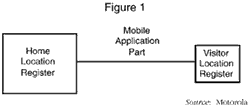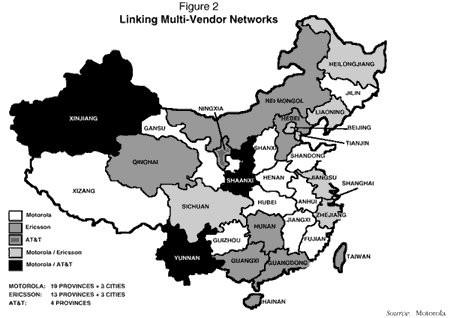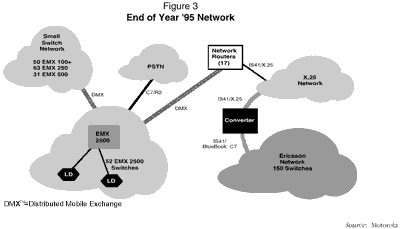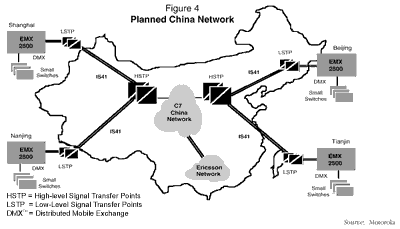
In the early years of wireless telephony, the cellular network was seen as little more than an extension of the existing local public switched telephone network (PSTN). At that time, adapting cellular telephones to operate outside their original local area was a cumbersome affair. Cellular operations on a new network, in a new area, on a different band, and using different protocols was simply not possible.
As the worldwide cellular market witnessed tremendous growth in the 1980s, heavy users among the business public demanded that their cellular telephones be available on a national basis. Soon, differing levels of roaming capabilities were offered as standard options for all users. With the advancement of technology, this important capability has become more automatic and seamless to users.
IS-41 is developed by the Telecommunications Industry Association (TIA) committee TR45.2, which is an accredited ANSI (American National Standards Institute) body. The protocol provides functionalities for automatic roaming, specifically roamer validation, call delivery, feature portability, adjacent market handoff, continuous subscriber service, and feature transparency.
The adoption of the IS-41 Mobile Application Part (MAP) signaling protocol by the ITU has major implications for communications that are critical to growing cellular networks. IS-41 is now a mobility standard that is supported in an ITU networking environment and, thus, uses ITU Common Channel Signaling (CCS). The first networks where IS-41 provided multi-million subscriber networking were in the United States. Specifically, IS-41 functions provide operations and procedures that:
The IS-41 standard is similar to the European Telecommunications Standards Institute (ETSI) Global System for Mobile (GSM) Communications digital MAP standard established in the late 1980s and has similar functionality for mobility management.
In the development of GSM digital technology, manufacturers and operators have learned from the growth of the analog network in the United States and Europe. This experience was reused in the definitions and exacting of the GSM network reference model and, in turn, created a wireless network mobility platform which includes the HLR, MAP, and Visitor Location Register (VLR).
The HLR/MAP/VLR relationship, as illustrated in Figure 1, has served as a mobility model for wireless networks around the world. HLRs provide for centralized subscriber data management but, most importantly, they allow for an exact network model where new nodes and service can be added without having to redefine every function in the distributed architecture-oriented network. The implementation of the HLR thus provides for linking the practical and the theoretical network reference model.

Although the models are similar, IS-41 and GSM, from a standards perspective, are quite different. IS-41 could, in the first phases (rev 0, rev A), be called a post-implementation standard. The actual commercial operation of networks that had already been implemented using different proprietary protocols and network references had to be considered for its formation. As a product of the combined early learning from major analog networks, IS-41 had thus created a learning basis for network evolution while gaining back the exacting network reference model from the standardization efforts. This allowed for a pragmatic approach to prioritizing features and a high level of operator input to the features standardized. This has continued for later revisions, such as revision C which was recently approved and revision D which is in standardization now.
Because all information is transferred independent of the telephone channels, it is possible to transfer different kinds of information via the signaling channel and to route the signaling in different ways through the system, depending on line conditions.
Signaling System #7 has been designed to provide different user groups with their own sets of messages. This makes it possible to implement new messages for one user group, such as IS-41 MAP messages, without affecting other user groups in the system.
The international use of C7 provides a high-speed, reliable means of communicating mobile call control and mobility transactions information (caller location, routing of addresses, subscriber categories, etc.) between switching systems. Under C7, there is also a faster called number setup than with register signaling oriented predecessors. In addition, C7 can mean a 10% savings in trunk utilization in a mobile switching center. The extra capacity of C7 means there is room to add enhanced services, such as one-number-service which provides for realtime translation of different network identities into one universal number.
The design of the C7 utilizes the ITU Open Network Architecture Layered Approach requiring the following layers and applications:
Message Transfer Part (MTP) -- This application ensures that all messages are transmitted error-free and in the correct sequence.
Signaling Connection Control Part (SCCP) -- Signaling information about circuit status and other information regarding location, billing, and services is tracked. The combination of MTP and SCCP is called the Network Services Part (NSP).
Transactions Capabilities Application Part (TCAP) -- The application defines the protocol that transfers vital information between control segments of the cellular network. The TCAP is specifically useful for non-call-related signaling which is needed for mobility support in cellular networks. IS-41 uses the ANSI TCAP. This is also defined in TIA Telecommunication Serve Bulletin TSB-29.
Mobile Application Part (MAP) -- This application on top of SCCP specifies the transfer of non-circuit information between Mobile Switching Centers (MSCs), including location updating/roaming, handoff, user authentication, incoming call routing information, subscriber service information, and non-call-related supplementary services (such as voice mail indicators, short message service, mobile station equipment identity, and authentication information). Signaling as defined by C7 (ITU-T) is similar to the US SS7 (ANSI) system.
The C7 signaling transport supports the IS-41 mobility protocol that permits cellular systems using air interfaces such as Advanced Mobile Phone Service (AMPS), Total Access Communications Systems (TACS), IS-54, IS-136, and Code Division Multiple Access (CDMA) (IS-95) to create large networks with millions of subscribers.
The importance of selecting the best network architecture principles and network technologies cannot be overstated. The effect of network outages multiplies with the size of the subscriber database. As could be seen from the end-user reaction on specific nationwide outages of signaling networks in the United States, the cost of regaining the confidence of subscribers in the service can be extremely high.
Equipment producers and operators need to plan for a crash-proof network so that mobile users will maintain their choice of wireless networks as the primary choice of both originating and terminating calls. A review of wireless service in China will provide a perspective on the ramifications of network growth.
THE NETWORK PROJECT
During the past two decades, China has developed one of the fastest-growing economies in the world. As is the case with most nations that strive to achieve world-class economic status, demand for telecommunications services and related infrastructure has also risen enormously.
Today, there are over 300 networked TACS analog cellular switches in China. To date, the bulk of the growth in cellular networks has been in TACS and, to a lesser degree, AMPS.
The short period of time in which this growth was achieved is even more amazing. China installed its first cellular system in Beijing in 1987. After a slow period of growth that ended in 1991, cellular use quickly expanded. Today, China has more than three million cellular subscribers.
As happened in nations adopting cellular in the past, the Chinese user community became increasingly mobile. This quickly brought demand for automatic roaming capability so subscribers could enjoy cellular service beyond their home cities or provinces.
By late 1992, the China Ministry of Posts and Telecommunications (MPT) established guidelines for the expansion of cellular service and the interconnection of systems. First, systems within each province were to be interconnected to enable automatic roaming capabilities within provinces. Following this, links between provinces were developed that would create automatic roaming service for all cellular subscribers.
In 1993, Motorola's Cellular Infrastructure Group (CIG) and the Directorate General for Telecommunications (DGT), China's day-to-day managing entity of cellular expansion, agreed on a plan to create a nationwide cellular network to meet MPT's framework. The first phase of this program would connect all cities and counties served by Motorola CIG switching equipment within each province. Later, all provinces and large cities served by Motorola CIG equipment would be linked.
The linking of multi-vendor networks (see Figure 2) envisioned by the MPT is a large-scale task. The program requires new or expanded cellular infrastructure equipment to be deployed for more than 95% of China's population. The MPT directive requires systems built by different vendors to work together seamlessly.

Figure 3 shows the basic structure of the Motorola cellular networks as of 1995. Here, Electronic Mobile Exchange (EMX) 2500 network switches handle cellular call management functions and voice communication at the local level. The EMX switches also function as the link between cellular users and the local PSTN. Cellular customers are connected to the National X.25 network through Tandem mainframe network routers and the Digital Access Connect System units for voice and data communication.

The X.25 to C7 converter was supplied by INET. This function has also (in the U.S. case, X.25 to SS7) been a critical component in the North American cellular network, as well as proven to be a highly useful basis for certification of the interaction of the differing networks.
This architecture provides basic roaming capability between subscribers in different cities and provinces. It was the first step in creating the multi-vendor "seamless" network envisioned by MPT.
In 1996, the cellular network in China will gain flexibility in several ways. First, inter-vendor roaming was put into place through IS-41 links to Ericsson-based networks.
The networks meet at what has been defined as high-level Signal Transfer Points (STPs) (see Figure 4). STPs help in providing the network for dedicated mobility message distribution and routing functions. Low-level STPs will be deployed as needed due to network architecture and message transactions capacity requirements.

The network uses the generally-accepted principle of reducing the number of STP layers in the overall network, which serves to reduce transactions delay for the various transactions transport cases. This principle was also used in the U.S. nationwide network.
The inter-system networking has created the largest nationwide roaming cellular network in the world. It will provide more than three million Chinese subscribers with automatic roaming services throughout the country's 26 mainland provinces, as well as in the cities of Beijing, Shanghai, and Tianjin.
The inter-system networking utilizes the North American industry-standard IS-41 (TIA) Revision B.
In China, the MPT acts as the equivalent of the TIA. As a result, it wrote the national specifications for interoperability.
The specification is using the TIA-defined IS-41 MAP and ANSI TCAP, while utilizing the ITU CCS routing and transport layers SCCP and MTP. This is also included in the specification that was recommended for adoption into ITU-R recommendation M.1073.
CDMA INTRODUCTION
By late 1996, second-generation CDMA digital technology will be introduced into China's cellular networks. The greatly increased capacity of CDMA will enable the cellular systems to accommodate more users, as well as offer value-added services such as over-the-air activation.
The addition of CDMA will coincide with a number of Intelligent Network upgrades. First will be the establishment of National and Regional Operations and Maintenance Centers (NMC). The NMCs will handle operations and maintenance functions for network routers, EMX 2500 switches, HLRs, and regional OMCs. This will provide benefits of lower costs and higher network reliability.
In this hierarchy, a Cellular Base Site Controller (CBSC) serves as the link to CDMA cells. This collects voice data user information from CDMA users and communicates it to the rest of the cellular network through dedicated EMX switches.
Together, the IS-41 protocols, C7 signaling transport, and the digital CDMA technology provide a reliable platform for expanding the breadth and depth of cellular service. This is a critical factor as wireless networks become an increasingly valuable asset and vital core technology worldwide.
Taken in this context, China's move to add roaming capability to its cellular networks is the next logical step in its economic progression. In this way, China not only assures itself a world-class mobile telephone system, it also unleashes the power of the mobile workforce across its nation.